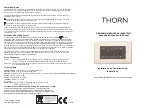
1-4
1) The node that needs to receive multicast data sends a graft message toward its upstream node, as
a request to join the SPT again.
2) Upon receiving this graft message, the upstream node puts the interface on which the graft was
received into the forwarding state and responds with a graft-ack message to the graft sender.
3) If the node that sent a graft message does not receive a graft-ack message from its upstream node,
it will keep sending graft messages at a configurable interval until it receives an acknowledgment
from its upstream node.
Assert
The assert mechanism is used to shutoff duplicate multicast flows onto the same multi-access network,
where more than one multicast routers exists, by electing a unique multicast forwarder on the
multi-access network.
Figure 1-2
Assert mechanism
As shown in
Figure 1-2
, after Router A and Router B receive an (S, G) packet from the upstream node,
they both forward the packet to the local subnet. As a result, the downstream node Router C receives
two identical multicast packets, and both Router A and Router B, on their own local interface, receive a
duplicate packet forwarded by the other. Upon detecting this condition, both routers send an assert
message to all PIM routers (224.0.0.13) through the interface on which the packet was received. The
assert message contains the following information: the multicast source address (S), the multicast
group address (G), and the preference and metric of the unicast route to the source. By comparing
these parameters, either Router A or Router B becomes the unique forwarder of the subsequent (S, G)
packets on the multi-access subnet. The comparison process is as follows:
1) The router with a higher unicast route preference to the source wins;
2) If both routers have the same unicast route preference to the source, the router with a smaller
metric to the source wins;
3) If there is a tie in route metric to the source, the router with a higher IP address of the local interface
wins.
Introduction to PIM-SM
PIM-DM uses the “flood and prune” principle to build SPTs for multicast data distribution. Although an
SPT has the shortest path, it is built with a low efficiency. Therefore the PIM-DM mode is not suitable for
large- and medium-sized networks.
















































